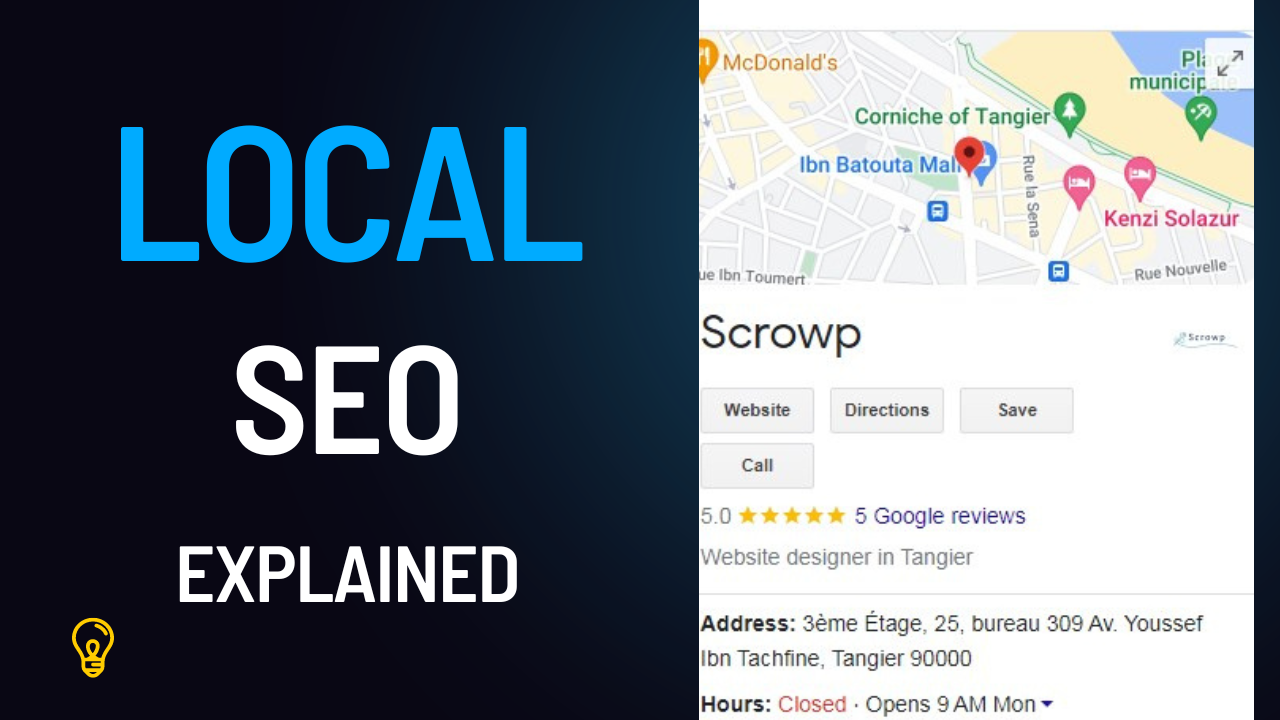
In this guide, learn how Google works with local sites, and optimize your site’s local search results to grow your business.
Local SEO is a search engine optimization (SEO) strategy that helps your business be more visible in local search results on Google.
What’s local SEO ?
Any business that has a physical location or operates in a geographic area can benefit from local SEO. If you search Google for any important keyword related to your business and a map with 3 results appears below (also called a Map Pack), then local SEO can help you grow your business.
How have search engines evolved?
In the early days of the Internet, there were relatively few websites, so browsing online was easy. However, when the Internet began to grow, search engines were created to make it easier for users to find the sites they were looking for.
If you entered a phrase into a search engine, that phrase was matched to websites that included the keywords entered in the search phrase. Google used this same approach, but quickly dominated other search engines by becoming the first search engine to use links between sites to indicate which websites were trustworthy and had authority.
Today, Google looks at hundreds of factors both on and off the website to determine if it’s relevant to display as a search result. The factors form your “digital fingerprint”, and each factor has a different weight or value, which the search engine combines to return results. When a user performs a search, it is your image or digital fingerprint that determines whether or not you will appear in the first rows or pages of Google results.
How does Google work?

When you type a search phrase into Google, it checks the pattern for various website signals, or ranking factors, like your site’s relevance, to return to a list of sites that match your search.
Most people don’t realize that Google doesn’t search the entire web live every time a user types something into the search bar. In reality, Google searches for a stored copy of all sites found. This copy is called the Google index.
To form the index, Google uses small programs called “spider” (literally, spider) to crawl the web. Each spider works the same way: the search starts on a single page, then follows the links on that page, looking for content on subsequent pages, and so on.
As web content is reviewed, it is stored on Google’s servers and the index takes shape. The spiders operate on an impressive scale, constantly crawling through trillions of pages at an incredibly fast pace. This ensures optimal index refresh, and rapid discovery of new sites and connections.
But to understand local SEO, you first need to know how Google works.
How Google Ranks Search Results
Google uses different processes to rank hundreds or thousands of sites at a glance. These processes are called algorithms. When you search on Google, an algorithm checks the index and returns a list of websites that match your search in organic results. These results are chosen and ranked according to the relevance, notoriety and popularity given by the incoming links.
The algorithm looks at different onsite and offsite factors to determine which websites are relevant to your search. All relevant sites are added to the list, which is then ranked in order of importance. Also related to the various on-site and off-site factors, the algorithm determines which sites best match your search query, and these sites are listed at the top of the search results.
Improving your SEO influences relevance, awareness and link performance factors for your website. If the right elements of your site’s digital footprint are optimized, your site will show up more easily in other search results.
Local SEO is different
What about local organic search results? After analyzing user behavior across trillions of searches, Google has concluded that people searching for certain types of businesses need results in their immediate area. This is why Google’s local search algorithm includes a proximity factor, i.e. Google takes your location into account when searching for a local keyword (a query with desire for local result ). This happens even when the person doing the search doesn’t include the city name or “near me” in their search.
For example, if you want pizza delivered to your office for lunch, you would type in “pizza delivery” and Google will display a list of locations near your office on its local search engine results page (SERP). .
But if you run that same search from home, you’ll get a completely different set of results. Which makes sense, because you want pizza delivered from a nearby restaurant.
Local search has been around for several years, but it was limited because people only used their desktop computers. In contrast, with the recent growth in mobile Internet access, mobile search has exploded; Local SEO has therefore become extremely important to the success of any business offering local products or services, as well as local sellers.
What you need to know about local SEO
Why is it important for search marketing? Although the local Map Pack shows up in standard Google search listings, the separate algorithms feed the main Google search results for local ranking and local Map Pack results. As a local business, you have the option of seeing both the main organic search results and the local Map Pack appear at the same time.
If you’re new to online marketing, one of your biggest challenges is deciding which areas to focus your efforts on to be as effective as possible.
Marketing analytics software company Moz releases its annual Local Search Ranking Factors Survey, which includes the top 35-40 international experts in the field of local SEO. Its results provide the best insights into the factors that influence local search visibility.
Localized content and local link popularity are factors, just like in the classic Google search algorithm. So it’s important to create local landing pages for each of your locations (especially if your business has multiple locations) and include your business name and information such as address and phone. You will also need to optimize title tags and meta descriptions, and follow SEO best practices. This needs to be factored into both your content marketing and link building strategy.
Additionally, location-based factors like the presence of a business listing in Google My Business, local citations from data aggregators, and verification signals (which should be posted by your local customers) are also considered. in your local SEO rankings.
Some local search-focused SEO tools can help you develop local SEO audits. This includes developing keyword research focused on your local audience, creating citations, managing Google My Business listings, business profiles and Google posts, and monitoring your integration into local packages.
Website content is an important factor, just like in the classic Google search algorithm, but location-based factors like Google My Business, citations, and verification signals are also included.
Start using SEO
Now that you better understand the basics of SEO and how Google ranks local search results, you can start focusing on signals that will optimize your site’s digital footprint in the local search ecosystem. This can help your business show up higher on the results page, which can lead to more potential customers finding out about your business.
There are many factors that affect your visibility in these searches, but keep in mind that local search continues to grow and evolve. To follow the upward and downward evolution of the signals and their relevance, you can refer to Moz’s annual survey to establish your strategy guide. By improving each important signal area, you will be able to serve more people in your geographic area and grow faster.
Further read : International SEO






4 thoughts on “What is local SEO and how does it work?”